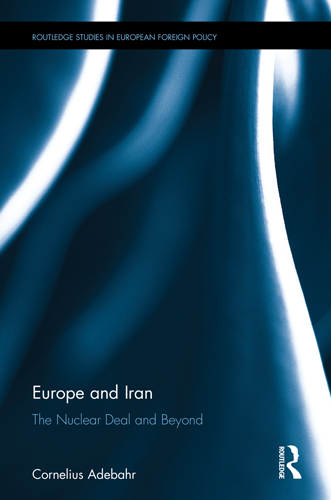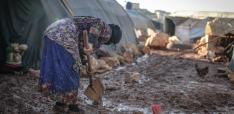Book Review - Europe and Iran: The Nuclear Deal and Beyond

Europe and Iran: The Nuclear Deal and Beyond by Cornelius Adebahr. Abingdon and New York: Routledge, 2017. 186 pp, £105 hardcover 9781138201040
Reviewed by Anoush Ehteshami
The Iran nuclear deal, formally known as the Joint Comprehensive Plan of Action (JCPoA), which took the first two years of the newly-elected President Hassan Rouhani’s term to complete and implement, has been under threat since the surprising election of Donald Trump to the American presidency. Trump’s bellicose rhetoric against the JCPoA as the ‘worst deal ever’ in history from 2016 tested the integrity of one of the most successful counter proliferation measures of the last 50 years, coming as it did in the wake of significant disarmament setbacks in Asia, namely the deepening nuclearization of the Indian subcontinent and the Korean Peninsula. The JCPoA provided the first platform for multilateral negotiations between Iran and all major powers and offered the prospects of slowly improving relations between Iran and the West in the course of Rouhani’s more amiable presidency. The JCPoA has survived thus far, but its future – in its current form at least – is increasingly in jeopardy and it is the tense conditions in 2018 which provide the backdrop for Adebahr’s excellent analysis of the JCPoA and the European role in ensuring its success. Trump’s approach is now testing Iran’s patience as well as Europe’s diplomatic mettle as both sides’ honest broker. Europe, having committed to the deal and invested in its success, is now confronted by the unpalatable choice of either sticking to the Atlantic alliance at Iran’s expense and have its diplomatic and political credibility questioned, or stick to the deal and tempt the White House to further marginalize Europe. So, what is at stake, what is the JCPoA all about, and why is it important? These are the key issues which Cornelius Adebahr’s book Europe and Iran grapples with.
 This insightful book achieves several tasks at once. It, first of all, brings to life European efforts to maintain clear lines of communications with Tehran, shedding light on the effectiveness and also international importance of European foreign policy engagement. Secondly, Adebahr provides a meticulous analysis of the multilateral context that European powers spent considerable energy and effort creating in anticipation of a negotiated deal being possible in the long-standing diplomatic stand-off between Iran and the international community over the country’s extensive nuclear programme. Thirdly, the book provides a valuable analytical chronology of the nuclear negotiations from the start of the crisis in 2002/3 to their final conclusion in July 2015. Finally, Adebahr skilfully dissects the key parts of the nuclear agreement to show its strengths and potential pitfalls as well as the regional fallout from what has been celebrated as a twenty-first century counter proliferation success story.
This insightful book achieves several tasks at once. It, first of all, brings to life European efforts to maintain clear lines of communications with Tehran, shedding light on the effectiveness and also international importance of European foreign policy engagement. Secondly, Adebahr provides a meticulous analysis of the multilateral context that European powers spent considerable energy and effort creating in anticipation of a negotiated deal being possible in the long-standing diplomatic stand-off between Iran and the international community over the country’s extensive nuclear programme. Thirdly, the book provides a valuable analytical chronology of the nuclear negotiations from the start of the crisis in 2002/3 to their final conclusion in July 2015. Finally, Adebahr skilfully dissects the key parts of the nuclear agreement to show its strengths and potential pitfalls as well as the regional fallout from what has been celebrated as a twenty-first century counter proliferation success story.
Reading this excellent book in the autumn/winter 2017/18, when dark clouds have been blowing over this historic deal from the Trump White House, does concentrate the mind and emphasizes in my mind the value of the nuclear agreement and the merits of preserving such multilateral agreements at all costs. As much is evident in this book, which takes the reader on a tour of the complex regimes ruling Iran and the EU as backdrops to the discussion of how a comprehensive agreement was finally crafted. Adebahr begins his study by a careful analysis of the EU’s multilateral policy framework, which in fact comes to serve well the process of ‘6+1’ negotiations which started in earnest in the latter days of the Ahmadinejad presidency in 2012/3. But the attention European powers paid to the workings of the Islamic Republic’s complex political system, itself discussed in chapter 3 of the book, should be highlighted as a key factor in the success of the negotiations. Unlike in the United States, European approaches were rooted in their pragmatic and non-ideological approach to foreign relations and their conviction, reached through the years of ‘critical dialogue’ and ‘constructive engagement’ with Iran, that talking was always better than confrontation and grandstanding. European countries did much to keep Tehran engaged with the West and offer Iranians the opportunities of trade and cultural exchanges across the Union’s 28 member states. Iranians, for their part, not only recognized this trait in the European approach but positively encouraged it at every opportunity. So, while the speculation at the time was all about the complex diplomatic dance taking place between Tehran and Washington, in reality it was in fact the Europeans who had subtly set up the dance floor for the nervous Iranian and American partners to get to know each other. Of course, what we do not hear much about in this book is the EU’s other role, namely its discreet contacts with the non-Western parties to the talks – China and Russia – who had relied on the E3 (Britain, France and Germany) to cajole an apparently willing United States to the talks.
So, why were the negotiations successful? Adebahr provides several reasons for this. Clearly, the political climate had changed sufficiently for the parties to contemplate dialogue: but one key reason was to be found in Europe’s own economic and foreign policy interests, helped by the EU’s unique multilateral approach. Following the disastrous 2003 Iraq war and the destabilizing effects of the Arab uprisings from 2011, Europe was keen to avoid another regional confrontation around Iran’s nuclear programme. But a nuclear-armed Iran would likely threaten Europe and its regional interests more than any other, so the EU had a built-in incentive to continue to build on its negotiating efforts in 2003/4 and to seek a compromise with Iran. But the EU also did not want to see a rise in Iran’s support for its non-state allies to use asymmetrical warfare as a defensive measure against the West. The EU also had another cause: to polish its tarnished diplomatic machinery following its divided and ineffectual efforts to manage G.W. Bush’s rush to war with Iraq. In that theatre Europe was divided and unable to provide a united front against military intervention, or support for state-building measures following the fall of the Ba’ath regime in Iraq in April 2003. Adebahr’s discussion of these issues is well-informed and insightful, and helps to underline his masterful analysis of the E3’s interest in crafting a united European position. This is a major contribution to our understanding of how the EU derives its ‘national security’ interests and the mechanisms at its disposal for addressing them.
The author goes further, however, and deeper, in analyzing the importance of the deal to Iran itself, and to the Atlantic alliance more broadly. As he rightly notes, the JCPoA is an achievement of multilateralism and should be valued for strengthening the non-proliferation regime. Today, sadly, the parties in Tehran who negotiated the JCPoA are vulnerable, and their actions to limit the fallout from the United States’ new hostilities can again create a rift in the Atlantic alliance – ironically the very thing which Europe wanted to heal as it embarked on crystalizing the negotiations into a durable treaty! The consequences of weakening the JCPoA fall well beyond these actors, however, and will have implications for multilateralism at the global level, and at a time when both Russia and China feel increasingly alienated from the Bretton Woods order.
Anoush Ehteshami is Professor of International Relations in the School of Government and International Affairs, Durham University.
Image credit: David Stanley via Flickr (CC BY 2.0)


